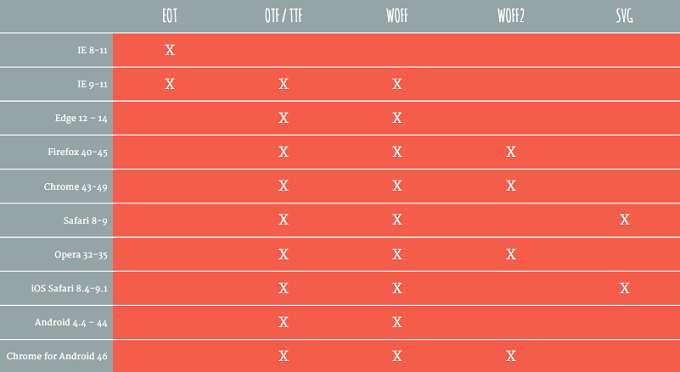csscross-browserfont-face
Is there a benefit to using multiple font file type sources when declaring a font-face?
I see a chunk of code declared as such:
@font-face{
font-family: 'SourceCodePro-Regular';
font-weight: 400;
font-style: normal;
font-stretch: normal;
src: local('SourceCodePro-Regular'),
url('assets/fonts/EOT/SourceCodePro-Regular.eot') format('embedded-opentype'),
url('assets/fonts/WOFF2/TTF/SourceCodePro-Regular.ttf.woff2') format('woff2'),
url('assets/fonts/WOFF/OTF/SourceCodePro-Regular.otf.woff') format('woff'),
url('assets/fonts/OTF/SourceCodePro-Regular.otf') format('opentype'),
url('assets/fonts/TTF/SourceCodePro-Regular.ttf') format('truetype');
}
Is there a benefit to having a bunch of different sources for this? ie. is there any benefit to requiring truetype, opentype, woff, woff2and embedded-opentype, or is there a source type that will work for everything?
I assume this is for a fallback, but the documentation doesn't really talk about this: https://developer.mozilla.org/en-US/docs/Web/CSS/%40font-face
Solution
The different file types are for different browsers.
Here is a nice overview:
Source: CreativeMarket
- CSS :after or :before reading dynamic values from HTML. No JS. Pure CSS
- jQuery button click not showing/hiding content
- How to style SVG with external CSS?
- How to Make an SVG Image Dynamically Match the Height (1em) and the Baseline of Surrounding Text?
- How to Apply Background Color for Children in a Repeating Pattern (Blue, Purple, Red)
- Text cropping when using overflow: hidden
- How to Position an Image on Different Sides of a Container Using CSS?
- How remove border around image in css?
- TailwindCSS: SVG icon won't resize properly
- Float CSS attribute causing parent div not to inherit height?
- Refused to apply inline style because it violates Content Security Policy (using hash for JQuery inline style)
- Show text outside the div with clip-path
- Flask/Jinja content not centering
- How to create a scalable document element inside a container in HTML
- Custom directive and [ngClass] on same element does not work
- How to add Font Awesome icon into <input> button?
- I can't set text after modifying the text
- Convert RGB color to English color name, like 'green' with Python
- Change / Hack style of Facebook 'Like it' button
- Selector :last-child not working as expected?
- Why does this strange space start appearing at the bottom of the page only on mobile?
- aspect-ratio not affecting parent size on ios/webkit
- make html text input field grow as I type?
- HTML text-overflow ellipsis detection
- Can we have an SVG background that tiles, with a gradient fill that doesn't?
- Dynamic Flickr background image for CSS tag
- how do I make text that goes below the screen on left div (screen split in 2 divs left and right) write itself on right div instead
- Set the position of divs to the far ends
- Applying a Stylesheet Within One Div Only
- Why `cursor: pointer` and `:hover` property is not being applied?
